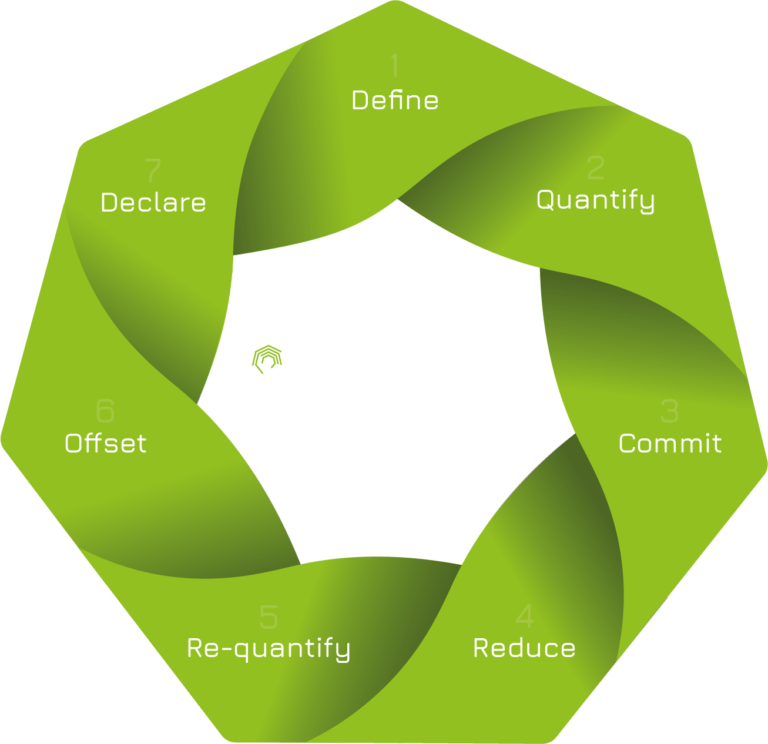As climate change gains greater global attention and businesses of all sizes recognise the importance of reducing their carbon footprint, implementing a robust and effective carbon reduction plan becomes crucial to future sustainability. In practice, this means adopting the Procurement Policy Note (PPN) 06/21 following government guidelines. An impactful carbon reduction plan also helps businesses align their operations with international requirements, such as ISO 14064 (carbon verification) and PAS 2060 (carbon neutrality), while demonstrating their commitment to environmental responsibility and enhancing their brand’s reputation.
With Carbonology’s® wealth of experience in assisting companies to achieve carbon neutrality and ISO standards, navigating the complexities of creating your first carbon reduction plan becomes a seamless and rewarding process.
This comprehensive guide will outline the essential steps for implementing your first carbon reduction plan, from conducting a carbon footprint assessment to setting emission reduction targets, engaging stakeholders, and monitoring progress. With the expert guidance of Carbonology®, businesses can embark on a journey towards sustainable growth, benefiting from enhanced operational efficiency and a positive contribution to the global climate change challenge.
Step 1: Conduct a Carbon Footprint Assessment
The crucial first step in creating a carbon reduction plan involves calculating your business’ carbon footprint to allow an understanding of your current greenhouse gas (GHG) emissions. This assessment helps identify emission sources, predominately focusing on Scope 1 (direct emissions) and Scope 2 (indirect emissions from purchased electricity). Including Scope 3 emissions (indirect emissions from the supply chain) offers a more holistic overview, so it is important for these to be represented.
Carbonology® provides support in calculating your emissions in alignment with the Greenhouse Gas Protocol, a globally recognised standard for measuring and managing GHG emissions. By leveraging our expertise, businesses can ensure a detailed and accurate reflection of their emissions.
Step 2: Set Emission Reduction Targets
After understanding your emissions, we’ll help you to set specific and ambitious (yet achievable) emission reduction targets. These targets are be based on clear timelines and guidelines, such as those recommended by the Science Based Targets initiative (SBTi). Some common target-setting approaches include:
- Absolute emission reduction targets: Reducing your company’s total GHG emissions by a specific amount or percentage over a given timeframe.
- Intensity-based targets: Reducing emissions per unit of production or revenue over a defined period.
Carbonology’s® expert guidance can help you develop appropriate targets that align with your organisational goals and support compliance with ISO 14064 and PAS 2060 standards.
Step 3: Develop an Emission Reduction Strategy
With clear targets established, we will help you to design a robust emission reduction strategy that encompasses the following considerations:
1) Resource Efficiency: Review your company’s energy and resource consumption, exploring opportunities for efficiency improvements and cost savings through technology upgrades, process optimisation, and behavioural changes.
2) Renewable Energy Procurement: Transition to cleaner energy sources by investing in renewable energy solutions, such as solar panels or procuring energy from renewable power providers.
3) Sustainable Procurement: Implement sustainable procurement practices across your supply chain, working with suppliers committed to environmental and social responsibility.
4) Employee Engagement: Foster a corporate culture supportive of sustainability by engaging and educating your employees on the importance of emission reduction and facilitating their active participation in implementing your carbon reduction plan.
5) Continual Improvement: Regularly review and adjust the strategy to account for new technological advancements, evolving industry best practices, and changing stakeholder expectations.
Carbonology’s® team of experts will help to devise and refine a tailored emission reduction strategy that reinforces your organisational values and enhances operational efficiency while adhering to ISO standards.
Step 4: Engage Stakeholders Throughout the Process
Effective stakeholder engagement is vital for the successful implementation of a carbon reduction plan, as it fosters transparency and collaboration. Key stakeholders to involve in the carbon reduction planning process include:
- Internal stakeholders: Employees, management teams and shareholders, ensuring that your carbon reduction plan is integrated into strategic decision-making, and employees are genuinely committed to its success.
- External stakeholders: Suppliers, customers, investors, and regulators, engaging in open dialogue regarding your carbon reduction goals, progress, and challenges, while seeking feedback and reinforcing collaboration.
Step 5: Monitor, Report, and Measure Progress
Measure the success and compliance of your carbon reduction plan by:
1) Establishing Key Performance Indicators (KPIs): Identify and track specific KPIs related to your emission reduction targets and overall carbon management strategy.
2) Conducting Regular Audits: Perform regular audits of your emission reduction efforts to assess the efficacy of implemented measures and ensure ongoing compliance with ISO 14064 and PAS 2060 standards.
3) Transparent Reporting: Share your progress with stakeholders through transparent and accurate reporting, such as annual sustainability reports or dedicated carbon reduction plan updates.
4) Continual Improvement: Learn from your successes and challenges, adapt your carbon reduction plan as needed, and seek new opportunities for further emission reductions.
Carbonology’s® support in monitoring and reporting your carbon reduction plan’s progress allows you to demonstrate accountability, foster stakeholder trust, and comply with ISO standards seamlessly.
Embarking on a Carbon Reduction Journey with Carbonology®
Developing and implementing an effective carbon reduction plan is crucial for businesses looking to align with international standards, demonstrate environmental responsibility, and contribute to a sustainable future.
By following the outlined steps and engaging with Carbonology’s® expertise in carbon neutrality and ISO standards, your organisation can successfully navigate the complex process of creating a carbon reduction plan while benefiting from increased operational efficiency, stakeholder trust, and a positive brand reputation.
Take the first step towards a sustainable future for your business by contacting Carbonology® today and exploring their bespoke Carbon Reduction Plan (PPN 06/21) service. As a dedicated partner in your journey towards carbon neutrality, Carbonology® is committed to supporting and guiding you at every milestone of your carbon reduction journey.

